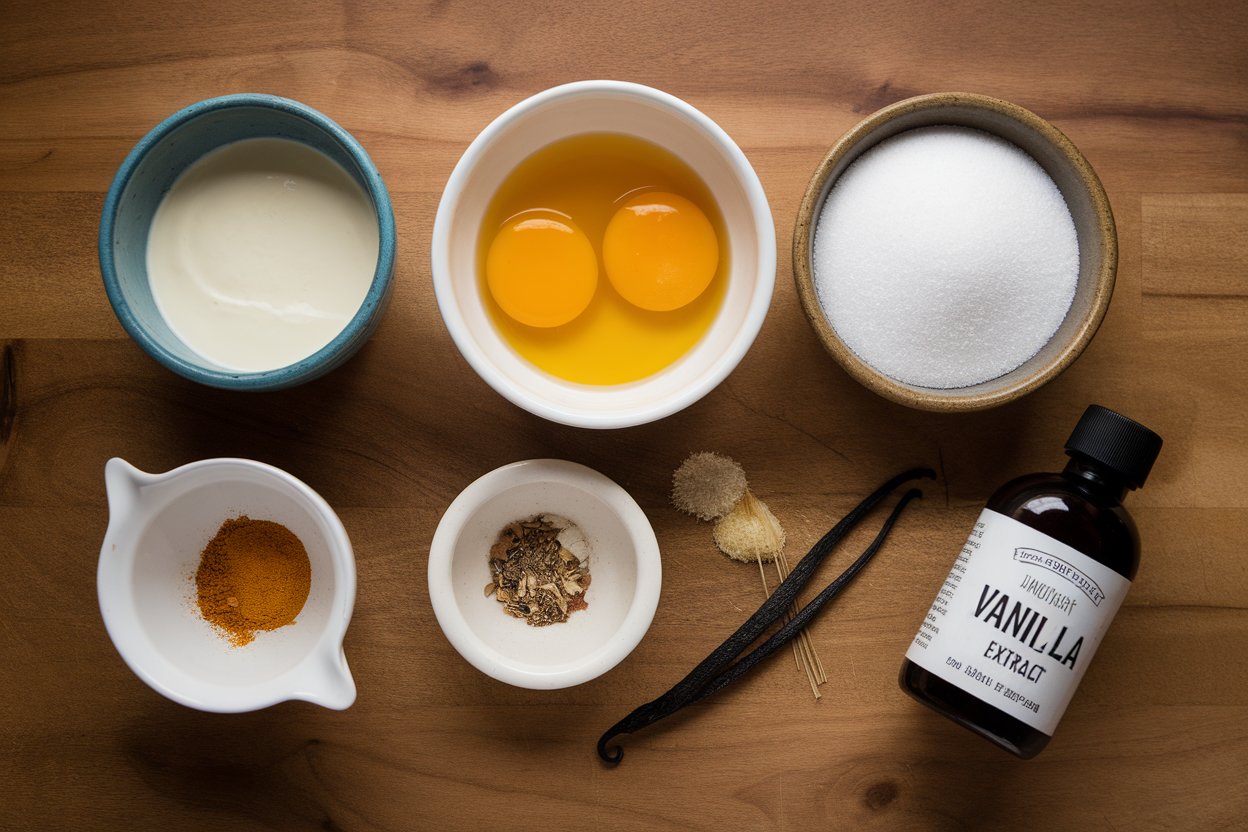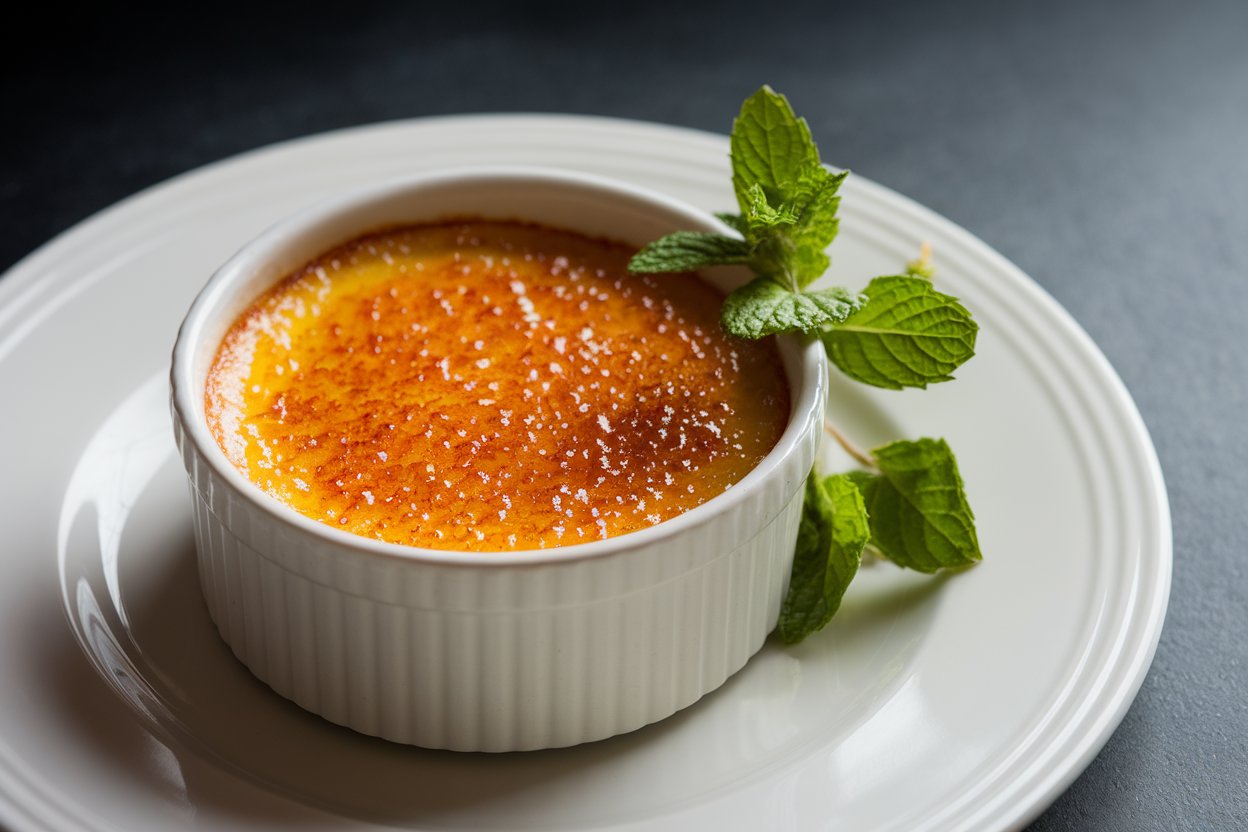Crème brûlée – it’s that silky, rich custard with a caramelized sugar crust that cracks like glass under the tap of your spoon. 🍮 It’s elegant, satisfying, and, honestly, feels like a hug for your taste buds. But here’s the big question: what type of cream should you use to make the best crème brûlée ever? Let’s dive into the details and find out!
Table of Contents
Understanding Crème Brûlée
What Is Crème Brûlée?
Crème brûlée is a classic French dessert that translates to “burnt cream.” It’s essentially a custard base topped with a layer of hardened caramelized sugar. The magic lies in its contrast: the creamy, melt-in-your-mouth custard against the crunchy, glass-like sugar layer. Sounds dreamy, doesn’t it? ✨
But getting that custard just right depends a lot on the cream you choose.
Key Ingredients of Crème Brûlée
Here’s what you’ll need to make this iconic dessert:
| Ingredient | Quantity |
|---|---|
| Heavy Cream | 2 cups |
| Egg Yolks | 5 large |
| Granulated Sugar | 1/2 cup (for custard) |
| Vanilla Extract | 1 tsp |
| Sugar (for topping) | 2-3 tbsp |
Each ingredient has a role to play, but the cream is the star of the show. It’s what gives crème brûlée its luscious texture and rich taste.
The Role of Cream in Crème Brûlée
Why Cream Is Essential for the Perfect Texture
Think of cream as the foundation of your crème brûlée. It’s the ingredient that brings everything together, creating that smooth, velvety custard. Without cream, the texture falls apart—literally and figuratively. 😅
Cream adds fat, which is essential for a silky, rich consistency. Too little fat, and your dessert could end up more like a pudding than a crème brûlée.
Balancing Flavor and Richness with Cream
Have you ever tasted a dessert that’s just… too heavy? The kind that makes you feel like you’ve swallowed a brick? 🧱 That’s what happens if you overdo the richness. The right cream balances flavor and texture perfectly, making each bite indulgent but not overwhelming.
Types of Cream for Crème Brûlée
Choosing the best cream for crème brûlée can feel overwhelming, but let’s break it down.
Heavy Cream: The Gold Standard
If crème brûlée were a Hollywood star, heavy cream would be its A-list agent. 🌟 It’s thick, rich, and has the perfect fat content (about 36-40%) to create that creamy texture we love. Most recipes swear by heavy cream because it delivers consistent, delicious results.
Pro Tip: Want to level up your crème brûlée game? Use high-quality heavy cream from a trusted brand. The better the cream, the better your custard.
Whipping Cream: A Lighter Alternative
Whipping cream is similar to heavy cream but has a slightly lower fat content (around 30-36%). If you’re looking for something a bit lighter but still creamy, whipping cream is a decent choice. However, it might not give you that same velvety texture heavy cream provides.
Double Cream: Rich and Luxurious
Double cream is like heavy cream’s fancy cousin from the UK. It has a fat content of about 48%, making it incredibly rich. While it’s not as common in the US, it’s worth considering if you’re going for a truly decadent experience. 🍽️
Half-and-Half: Is It a Viable Option?
Half-and-half is a mix of cream and milk with a fat content of about 10-18%. It’s way too light for crème brûlée. While it might work in a pinch, your custard will likely lack that rich, creamy texture.
Plant-Based Cream Alternatives: Are They Suitable?
If you’re going dairy-free, plant-based creams like coconut cream, almond cream, or soy cream can work. But keep in mind, they’ll change the flavor profile significantly. Coconut cream, for example, will add a tropical twist. 🌴 It’s not traditional, but it’s still delicious!
Comparing Dairy and Non-Dairy Cream Options
Pros and Cons of Using Dairy Creams
Dairy creams like heavy cream and whipping cream are traditional for a reason—they create the ideal texture and flavor. But they’re not for everyone, especially if you’re lactose-intolerant or vegan.
| Pros of Dairy Cream | Cons of Dairy Cream |
|---|---|
| Rich, creamy texture | Not suitable for vegans |
| Traditional flavor | Contains lactose |
| Widely available | Can be high in calories |
Evaluating Plant-Based and Vegan Creams
Plant-based creams are a great alternative if you’re avoiding dairy. However, they require a bit of experimentation to get the texture and flavor just right.
| Pros of Plant-Based Cream | Cons of Plant-Based Cream |
|---|---|
| Suitable for vegans | May alter the flavor |
| Lactose-free | Might need stabilizers |
| Can be healthier | Limited availability |
Common Problems with Cream in Crème Brûlée
Even with the best cream, things can go wrong. Let’s troubleshoot some common issues.
Problem 1: Why Does My Custard Not Set Properly?
This usually happens if your cream-to-egg ratio is off or if the custard isn’t cooked long enough. Make sure you’re using the right amount of cream (stick to the recipe!) and bake it in a water bath to avoid overheating.
Problem 2: Why Is My Crème Brûlée Too Runny?
Runny custard can result from undercooking or using cream with too little fat. Heavy cream is your best bet for avoiding this issue.
Problem 3: Overheating and Its Effect on the Cream
Overheating your cream can cause it to separate or curdle. Always heat it gently, just until it’s warm—not boiling. 🔥
Quick Tip: Use a thermometer to keep an eye on the temperature. Aim for around 160-180°F.
Tips for Selecting the Best Cream for Crème Brûlée
Here are some insider tips to help you choose the right cream:
- Check the Fat Content: Look for creams with at least 36% fat.
- Choose Fresh, High-Quality Cream: The fresher, the better!
- Avoid Ultra-Pasteurized Creams: They often have additives that can affect the texture.
Exploring Flavor Variations with Different Creams
So, you’ve mastered the basics of crème brûlée, but why stop there? Let’s take it up a notch and explore some fun ways to play with flavors while keeping that iconic creamy texture intact.
Using Infused Creams for Enhanced Flavor
Infusing your cream is like giving your crème brûlée a personality. 🌟 Here’s how you can experiment:
- Vanilla Bean: Instead of vanilla extract, split a vanilla bean and let it steep in your cream while it heats. The tiny black seeds make it look fancy, and the flavor? Divine.
- Citrus Zest: Add a little zest from oranges, lemons, or limes to give your dessert a refreshing twist. 🍊
- Spices: Cinnamon sticks, star anise, or even cardamom pods can make your crème brûlée feel like a warm hug on a chilly evening.
- Herbs: Feeling adventurous? Try steeping rosemary or lavender for a unique, aromatic dessert.
Pro Tip: After infusing, strain the cream to remove any solids before mixing it with the other ingredients.
How Cream Impacts Sweetness and Caramelization
The type of cream you use can subtly change how your crème brûlée tastes and looks. For example:
- Heavy Cream: Its richness balances sweetness perfectly, giving you a creamy, satisfying custard.
- Whipping Cream: A bit lighter, it can make the dessert feel less indulgent but still delicious.
- Plant-Based Creams: These can add unexpected flavors—like coconut cream adding a hint of tropical sweetness.
Step-by-Step Guide to Making Crème Brûlée with the Best Cream
Ready to put theory into practice? Let’s make the ultimate crème brûlée! 🎉
Step 1: Preparing the Ingredients
First things first: gather your ingredients. Remember, quality matters, so use fresh cream, good eggs, and pure vanilla extract. Here’s a quick refresher on the ingredient list:
| Ingredient | Quantity |
|---|---|
| Heavy Cream | 2 cups |
| Egg Yolks | 5 large |
| Granulated Sugar | 1/2 cup (for custard) |
| Vanilla Extract | 1 tsp |
| Sugar (for topping) | 2-3 tbsp |

Step 2: Heating the Cream
Pour your heavy cream into a saucepan and heat it gently over medium heat. Add your flavor infusions if you’re feeling fancy. Warm it just until it starts to steam—don’t let it boil. 🚫🔥
Quick Tip: Stir occasionally to prevent the cream from scalding.
Step 3: Mixing the Egg Yolks and Sugar
In a separate bowl, whisk the egg yolks and granulated sugar together until the mixture turns pale and slightly thick. This step is crucial for creating a smooth custard base.
Block Quote: “Take your time here. The better you mix, the smoother your custard will be!”
Step 4: Tempering the Eggs
This step sounds intimidating, but it’s super easy. Slowly pour the warm cream into the egg mixture, whisking constantly. This prevents the eggs from scrambling. Trust me, no one wants scrambled eggs in their crème brûlée. 😬
Step 5: Baking the Custard
- Preheat your oven to 325°F (160°C).
- Pour the custard mixture into ramekins (small ceramic dishes).
- Place the ramekins in a deep baking dish and fill the dish with hot water until it reaches halfway up the sides of the ramekins. This water bath ensures gentle, even cooking. 🛁
- Bake for 35-45 minutes or until the edges are set but the center jiggles slightly.
Step 6: Chilling the Custard
Once out of the oven, let the ramekins cool to room temperature, then refrigerate them for at least 4 hours (overnight is even better). This step helps the custard firm up and develop its creamy texture.
Step 7: Caramelizing the Sugar Topping
The grand finale! Sprinkle a thin, even layer of granulated sugar over the custard. Use a kitchen torch to caramelize the sugar until it turns golden brown and forms a hard crust. Don’t have a torch? Pop them under a broiler for a few minutes, but keep a close eye—they can burn fast! 🔥
Expert Recommendations: Best Cream Brands for Crème Brûlée
Finding the right cream can feel like a scavenger hunt, but here are some tried-and-true options:
Top Dairy Cream Brands
- Horizon Organic Heavy Cream: Rich, creamy, and reliable for desserts.
- Land O’Lakes Heavy Cream: A classic choice that’s widely available.
- Organic Valley Heavy Whipping Cream: Perfect for those who prefer organic ingredients.
Best Plant-Based Cream Brands
- So Delicious Coconut Creamer: Great for a tropical twist.
- Elmhurst Almond Cream: A mild, nutty option.
- Silk Heavy Whipping Cream Alternative: Smooth and versatile for dairy-free recipes.
FAQs About Cream and Crème Brûlée
Can I Use Milk Instead of Cream?
Technically, yes, but it’s not ideal. Milk lacks the fat needed for that creamy texture, so your custard might end up watery or thin. If you’re in a pinch, you could mix milk with a bit of butter to mimic cream, but don’t expect the same results.
Is Low-Fat Cream Suitable for Crème Brûlée?
Low-fat cream isn’t the best choice. The fat content is what gives crème brûlée its luxurious mouthfeel. Stick with heavy cream for the best outcome.
Conclusion
Crème brûlée is one of those desserts that feels like pure magic. ✨ From the smooth custard to the crunchy sugar topping, every bite is a symphony of textures and flavors. Choosing the right cream—whether it’s heavy cream, double cream, or a plant-based alternative—can make all the difference in creating the perfect custard. So, what are you waiting for? Grab your cream of choice and start cracking! 🥄
Final Thought: “The best crème brûlée isn’t just a dessert—it’s an experience. And with the right cream, it’s an experience you can perfect every single time!”


1 thought on “What type of cream is best for crème brûlée ?”